Meme Creation Guide: 7 Step Meme Creation Process
How to Create Memes that can go viral
Use AI to create memes. Enter text below
Step 1: Choose Your Meme Topic
What do you want to create a meme about? Your meme topic should be something that is relatable and relevant to your audience. It could be a current event, a popular culture reference, or even a personal experience.
Know Your Audience
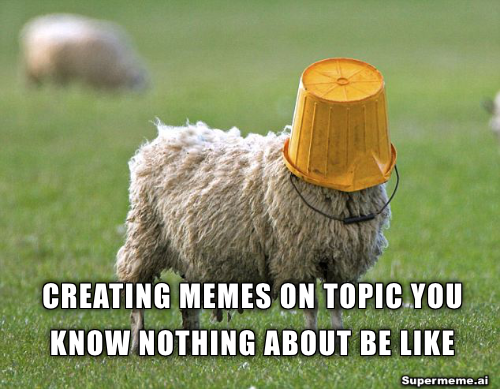
The first step in choosing a topic to meme about is to know your audience. You should have a clear understanding of who your audience is and what kind of content they enjoy. This will help you choose topics that are relatable and engaging.
If you're creating memes for a business or brand, you should also consider your target market. Your memes should align with your marketing strategy and brand values.
Know Your Expertise
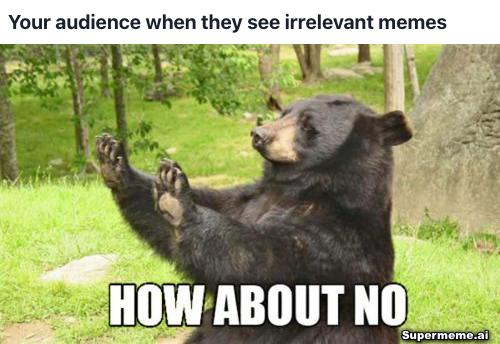
Creating a meme about something you know can be extremely beneficial because it showcases your knowledge and skills in a humorous and approachable way. People tend to remember and share things that make them laugh and resonate with them, making creating a meme about your expertise a powerful tool for self-promotion and brand-building. Additionally, it can help you connect with others who share your interests and potentially open up new opportunities.
By creating a meme about something you know, you are demonstrating your unique perspective while also potentially broadening your audience.
Know Your Goal
Creating a meme just for the sake of it or because it's trendy may not necessarily yield the results you're looking for. Therefore, before you start creating a meme, you need to ask yourself why you want to do it and what you hope to achieve. Are you creating a meme to promote a product or service? Do you want to entertain or educate your audience? Are you trying to build your personal brand or increase your social media following? Once you know your goal, you can then tailor your meme to suit your purpose, whether it be through the choice of images, text or tone

Step 2: Choose Your Meme Template
Now that you know what you want to meme about, the next step is deciding which meme template you're going to use to create your memeA meme template is a pre-made image or video that serves as a framework for creating memes. These templates usually have a basic layout, text, and images that can be edited to fit the creator's desired message.
Before choosing a meme template, it's crucial to understand the purpose of your meme. Are you trying to make people laugh, convey a message, or promote a product? The purpose of your meme will determine the tone, format, and style of the meme.
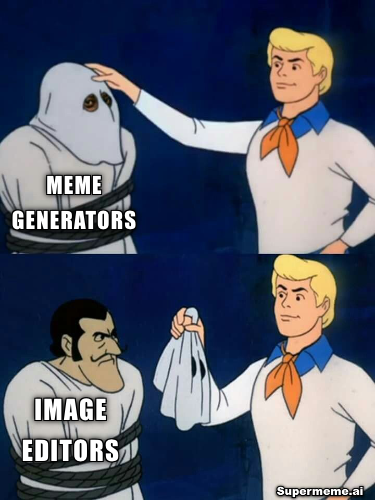
Tips for choosing meme templates
- Stay away from overused or outdated templates to ensure that your meme stands out and isn't ignored by your audience.
- Choose a template that strikes a balance between being new and fresh, yet still widely recognizable and adaptable to your message.
- Consider the simplicity of the template, as complicated or cluttered images can make it difficult for your audience to understand or appreciate your meme.
- Ensure that the image and the text you add to the template are coherent and have a clear message.
- Take into account the context and meaning behind the template, as this can affect how your audience interprets your meme.
- Never choose NSFW templates or potentially offensive templates
How to choose meme templates
- Based on Your Personal Preference: This entails simply choosing something that you like and find funny. You can choose a meme template based on your sense of humor or your personal interests.
- Based on Your Audience's Interest: You can also choose a meme template based on your audience's interests. Consider what type of content your followers would be interested in and choose a meme template that matches their preferences.
- Based on the Trending Memes: You can also choose a meme template that is currently trending in the digital space. Check out social media platforms, blogs, and news sites to see what memes are making waves and choose a template that aligns with the current trends.
- Based on the Meme's Message or Goal: You can also choose a meme template that supports your message or goal. Consider the tone of your message and the emotion your meme wants to convey before selecting the template.
- Based on the Image's Quality: Find a meme template that is visually appealing, with high quality images, and a good layout. Often high-quality image templates lead to excellent memes
- Repurpose an Existing Meme: Repurposing an old meme format with new text can attract attention while infusing a fresh context to the meme.
Step 3: Pick a Meme Generator
The next step is to create a meme using a meme generator. A meme generator is an online tool that lets you 'generate' memes. Meme generators can be seen as glorified image editors because they essentially allow users to add text onto existing images. While some meme generators may have additional features such as built-in templates or pre-made text options, they ultimately provide a simplified version of what image editing software such as Photoshop can offer.
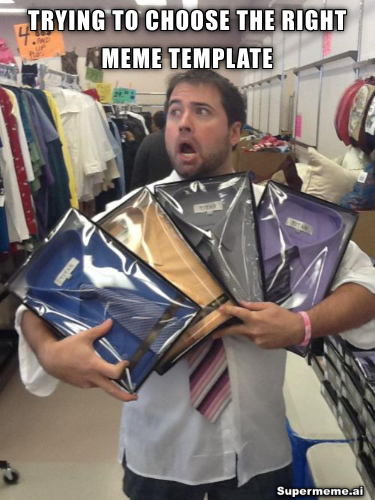
Some of the popular meme generators include:
- Canva
- ImgFlip
- MemeGenerator
- Adobe
- MakeMeme
Once you've picked a meme generator, it's time to start creating your meme.
Try AI Meme Generator for free today
No Credit Card Required. Your first 10 AI memes are on us.
Step 4: Write Meme Caption
Once you have chosen your meme generator, the next step is to write your meme caption on the meme template
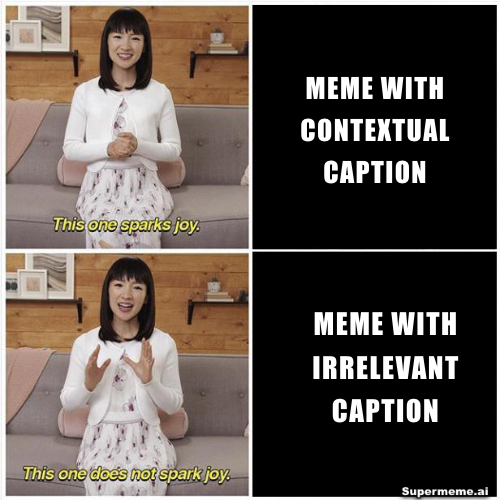
Things to consider while writing a meme caption
- Relevance: The caption you choose should be relevant to the meme template itself. Ensure that your caption complements the image or video and captures the message you intend for your audience to take from the meme. A relevant caption also helps to establish credibility and adds legitimacy to the meme, making it more shareable and popular.
- Conciseness: A good meme caption should be crisp and to the point, catching the viewer's attention within seconds. Aim for concise and clear captions that get right to the point without beating around the bush. Captions that are too lengthy are likely to be ignored, overlooked or deemed boring to viewers. Keeping it simple and comprehensive delivers the intended message with greater clarity.
- Humor: Humor is a key element of a successful meme. People are looking for a laugh or a chuckle, so using humor in your caption helps achieve the intended effect. Use witty and clever humor to draw in viewers and keep them engaged. A good meme is funny and enjoyable, so crafting a caption that tickles the viewer's funny bone is critical.
- Originality: Memes thrive on originality. If you use a template that is popular and well-known, add your own spin to the caption. Crunch some numbers or use unique puns that make the meme fresh and stand out. This helps in creating a sense of ownership over the template, making the meme authentically yours.
Step 5: Format Your Meme
After adding your text, it's time to customize your meme. You can add filters, adjust the size and position of your text, and even add stickers or emojis to make your meme more engaging. It's important to consider formatting when creating a meme to ensure it reaches the largest possible audience. Social media platforms and presentation software have different aspect ratios, or the ratio between the length and width of an image.

Here are some tips on how to format your meme for different sharing needs:
- Instagram: The ideal aspect ratio for an Instagram post is 1:1. This means that the width and height of the image should be the same size. To post your meme on Instagram in the best quality, create an image size with a resolution of 1080 x 1080 pixels.
- Facebook and LinkedIn: On these platforms, the ideal aspect ratio is 16:9, meaning the width should be 16 units and the height should be 9 units. To ensure that your meme fits this aspect ratio and looks good on desktop and mobile devices, make sure the image size is a minimum of 1200 x 630 pixels.
- Twitter: Twitter's ideal aspect ratio is 2:1, meaning the width should be twice the size of the height. For Twitter, create an image size of at least 1024 x 512 pixels to ensure the highest possible quality.
- Presentations: When creating a meme for use in a presentation, the ideal aspect ratio is 16:9 or 4:3. The resolution of a high-quality image for use in a presentation should be at least 1280 x 720 pixels.
- Other Shared Formats: When sharing your meme via other digital channels like email, messaging apps, or blogs, consider size limits as well as aspect ratio requirements. Check the specifications of the platform for optimal quality and sharing impact.
This inconsistency of image size and quality hinders its shareability and limits the meme's reach to the intended audience, resulting in poor engagement rates, lost impact, and fewer click-throughs. One of the most noticeable issues you're likely to experience is that your meme may look oddly cropped or stretched when viewed on different devices, resulting in users scrolling past it without paying much attention.
Step 6: Share Your Meme
Once you have created your meme, it's time to share it with the world. You can share your meme on social media platforms like Facebook, Instagram, and Twitter. You can also share your meme on forums, communities or message boards that are relevant to your meme topic.
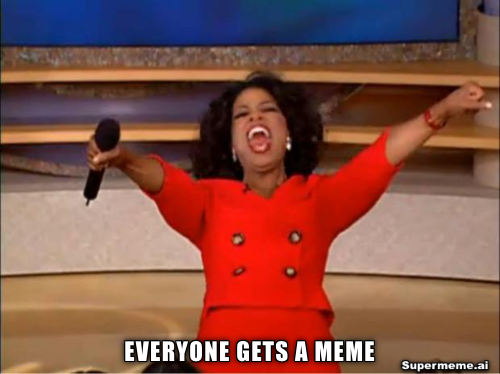
Tips to share your meme
- Relevance: Ensure that your meme is relevant in the context it is being shared. Sharing a meme that has nothing to do with the topic or audience could cause confusion or indifference.
- Appropriateness: It is essential to ensure that your meme is appropriate and doesn't contain offensive language, images or themes. Avoid sharing content that could be seen as inappropriate or offensive to any group of people.
- Target Audience: Know your target audience for whom the meme was tailored to. The content, humor, tone, and format should resonate with the intended audience.
- Timing: Posting your meme at the right time is critical to maximizing its impact. Consider the time zone or broadcast schedule of your target audience, and posting when they are most active would be more effective.
- Quality: Ensure that your meme is of high quality and is legible. A high-quality image and text gives it the intended impact.
- Attribution: Always give credit where credit is due. Give attribution to the original source of the meme when reposting, or share the link for viewers to provide great meme discovery.
- Sharing Guidelines: Some social media platforms have specific guidelines regarding meme sharing. It essential to review such guidelines to avoid brand infringement or license agreements.
When sharing your meme, make sure to use relevant hashtags and tag relevant people or brands. This will help your meme reach a wider audience and increase its visibility.
Step 7: Monitor feedback
After sharing your meme, it's important to monitor its performance. You can use social media analytics tools to track the engagement and reach of your meme. This will help you understand what works and what doesn't, and make improvements for future memes.
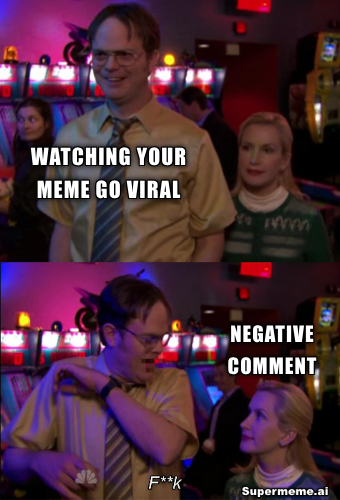
Here are a few areas to consider:
- Track Engagement: Use analytics tools to track how your meme is being received. Monitor likes, shares, and comments to determine if people are engaging with it effectively.
- Respond to Comments: Interact with your audience by responding to comments or questions. Acknowledge their positive feedback or address concerns politely.
- Gauge Sentiment: Keep a weather eye on the sentiment surrounding your meme. Use the right tools to gauge if they are in line with what was intended. This will help you tailor messaging more effectively.
- Take It Down: If your meme receives negative comments or feedback that you believe crosses ethical or moral bound, then take it down. React quickly, apologize and make amends.
- Learn from Feedback: Use the feedback you receive to improve your future meme creations. Assess the constructive criticism and apply it to the next project.
- Stay Professional: Remain professional when engaging with your audience, especially in cases where negative comments or feedback occur. Respecting people's view and keeping a professional image enhances your brand value.
FAQs
- How long does it take to create a meme? Creating a meme can take anywhere from a few minutes to a few hours, depending on the complexity of the meme and the tools you are using.
- Can I use copyrighted images in my memes? No, it's not recommended to use copyrighted images in your memes without permission from the owner.
- How do I make my meme stand out? Make sure your meme is relatable, funny, and visually appealing. Use relevant images and clear, concise text.
- How do I track the performance of my meme? You can use social media analytics tools to track the engagement and reach of your meme.
- Can memes be used for marketing purposes? Yes, memes can be a powerful tool for marketing and increasing brand awareness. However, it's important to make sure your memes align with your brand values and personality.
- Can memes be created with APIs? Yes, you can create memes using APIs. It's a powerful tool for anyone looking to leverage APIs at scale.